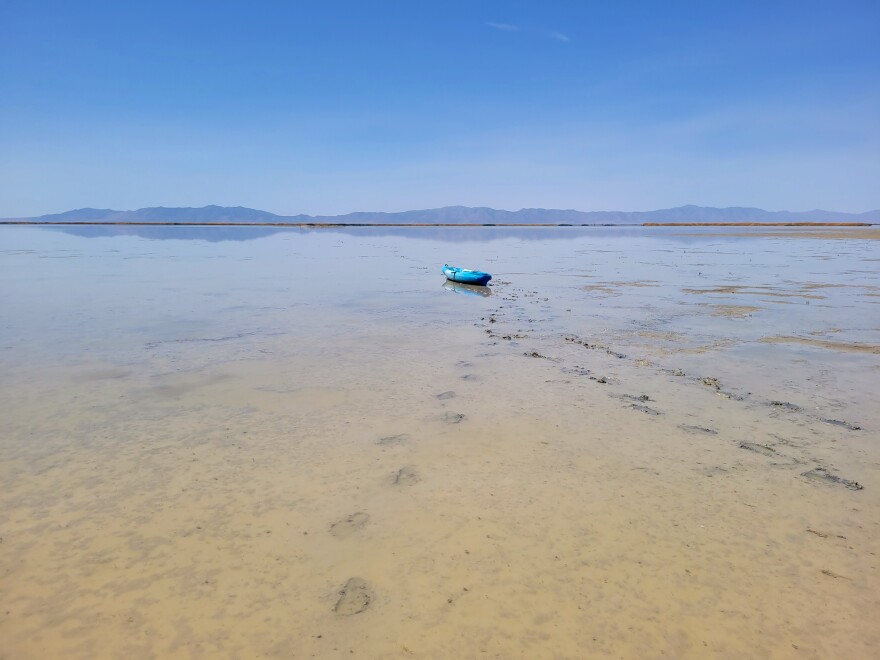Last month, UPR explored the ramifications of Great Salt Lake’s declining water levels for Utah’s people and wildlife, but what’s being done to stop the decline?
One of the major challenges for ensuring water gets to the lake is the fact that Great Salt Lake does not have a legal right to any of its water. The state of Utah owns the lake bed, but those lands aren’t guaranteed water.
Laura Vernon, the Great Salt Lake coordinator for the Utah Division of Forestry, Fire and State Lands, hopes that changes can be made to give the lake more control over its water.
“We're hopeful that during this legislative session an ‘in stream flow bill’ will be brought to the legislature that looks at changing who can hold water rights in the state,” Vernon said.
Another challenge for Great Salt Lake is that Utah wastes a lot of water. Sarah Null is an Associate Professor in Watershed Sciences at Utah State University,
“We have the second highest water consumption in the United States. And that's surprising given that we're such an arid state, but other dry states like Arizona and New Mexico and California and Nevada, show that people can use much less water,” Null said.
In an effort to reduce Utah’s water waste, Governor Cox announced in July four areas of water conservation focus. He advocated for a statewide installation of secondary water meters, which can reduce secondary water usage up to 30 percent, along with integrated land use and water planning, agricultural water use optimization, and a push for Utah to be the first to offer a statewide turf grass buyback program.
In 2019, the Utah Legislature passed a resolution recognizing the importance of solving declining lake levels. The resolution aimed to help local governments figure out how to implement better water planning practices and allocate water directly to Great Salt Lake.
This fall, Rio Tinto Kennecott and Central Utah Water Conservancy District, in collaboration with a number of state and local partners, committed to delivering 21,000 acre-feet of water per year from the Jordan River to Great Salt Lake’s Farmington Bay for the next decade.
While short term changes from the 2019 resolution are beneficial, Marcelle Shoop, the Director of the Saline Lakes Program for the National Audubon Society, stressed the importance of longer-term solutions. “And so the idea of being able to get water to Great Salt Lake and put it to use in those areas where we need to is really, really important. But we also need these other long-term actions,” Shoop said.
This year Senator Mitt Romney and Representative Blake Moore introduced legislation, informally referred to as the “Saline Lakes Bill”, which aims at addressing the issue of all shrinking saline lakes, including Great Salt Lake.
Shoop said the bill helps build a greater scientific foundation to base management decisions off of, “with the focus being understanding what's happening with these lakes, from an integrated perspective, water quality, water quantity, ecological resources, and then using that science and information to actually help foster coordinated action across a number of jurisdictions and hopefully protect this larger network of saline lakes.”
Null spoke to the benefits of water banking, which enables holders of water rights to sell a portion of their water but still retain their rights to it. Bolstered by the Water Banking Act in 2020, water banking is being rolled out in several pilot programs currently, including one in Cache Valley.
“I've just recently done some analysis looking at how much water Cache Valley Water Banking could bring to Great Salt Lake, and I've estimated that if in only wet years if water were purchased from willing sellers, that Great Salt Lake could be about one to two and a half feet higher than it is today, if we had been engaged in wet year water banking,” Null explained.
Null felt water banking could play a role in the agricultural sector as well, allowing farmers to irrigate a portion of their land and lease the remaining water for profit.
Currently, Utah’s agricultural sector accounts for about 75% of the state’s total water use. Vernon said changing attitudes and water infrastructure funding may improve irrigation efficiency, “People are starting to see the importance of optimizing water use not only for the Great Salt Lake, but for their own agricultural practices. So another exciting opportunity that we have coming up is a result actually through the COVID relief funding where a lot of that in Utah is focused towards water infrastructure and water use. So, we can work with agricultural communities to optimize how they use water by providing infrastructure to them that lets them irrigate their crops more efficiently.”
While the situation is dire, there’s a sliver of hope for the future. Both state and private institutions have enacted stricter watering guidelines, and Vernon said she’s seen a heartening uptick in concern about the lake.
“We've had more and more legislators this year, asking us about Great Salt Lake and what we can do and what needs to be done. And so that's just, you know, hasn't happened before...and so, yeah, changing hearts and minds. I guess we're working on now,” Vernon said.




